Business and Business Environment Analysis of Nestle Report
VerifiedAdded on 2020/10/05
|11
|3130
|212
Report
AI Summary
This report presents a comprehensive analysis of Nestle's business environment. It begins with an introduction to the concept of the business environment and its impact on organizational operations, focusing specifically on Nestle, a prominent food and beverage company. The report then delves into Task 1, exploring the positive and negative impacts of macro-environmental factors (political, economic, social, technological, environmental, and legal) on Nestle's business. Following this, Task 2 provides a detailed SWOT (Strengths, Weaknesses, Opportunities, and Threats) analysis of Nestle, identifying both internal and external factors influencing its performance. The report further examines the interrelation between Nestle's strengths and weaknesses with the identified macro-environmental factors. Overall, the report offers insights into Nestle's strategic positioning, challenges, and opportunities within its operating environment.
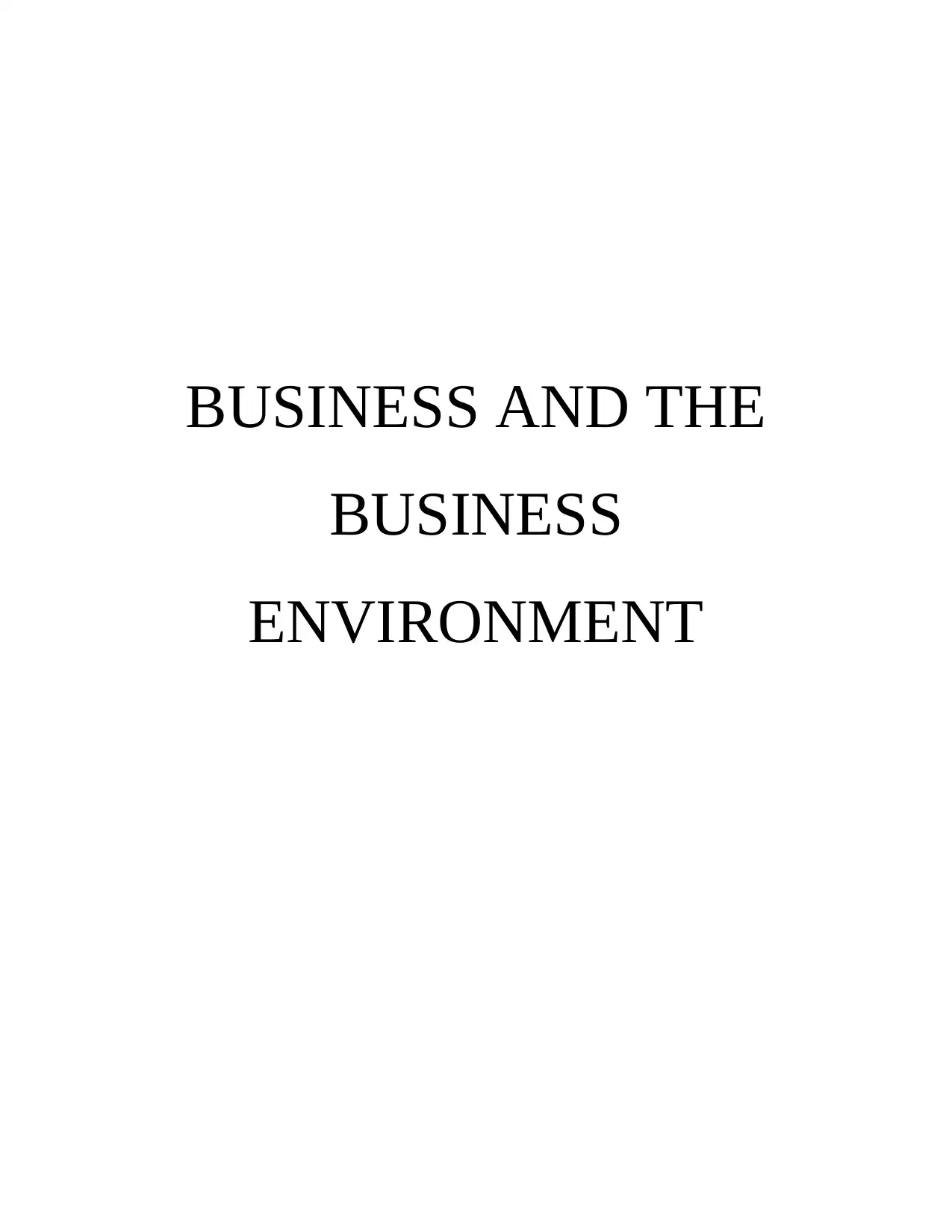
BUSINESS AND THE
BUSINESS
ENVIRONMENT
BUSINESS
ENVIRONMENT
Paraphrase This Document
Need a fresh take? Get an instant paraphrase of this document with our AI Paraphraser
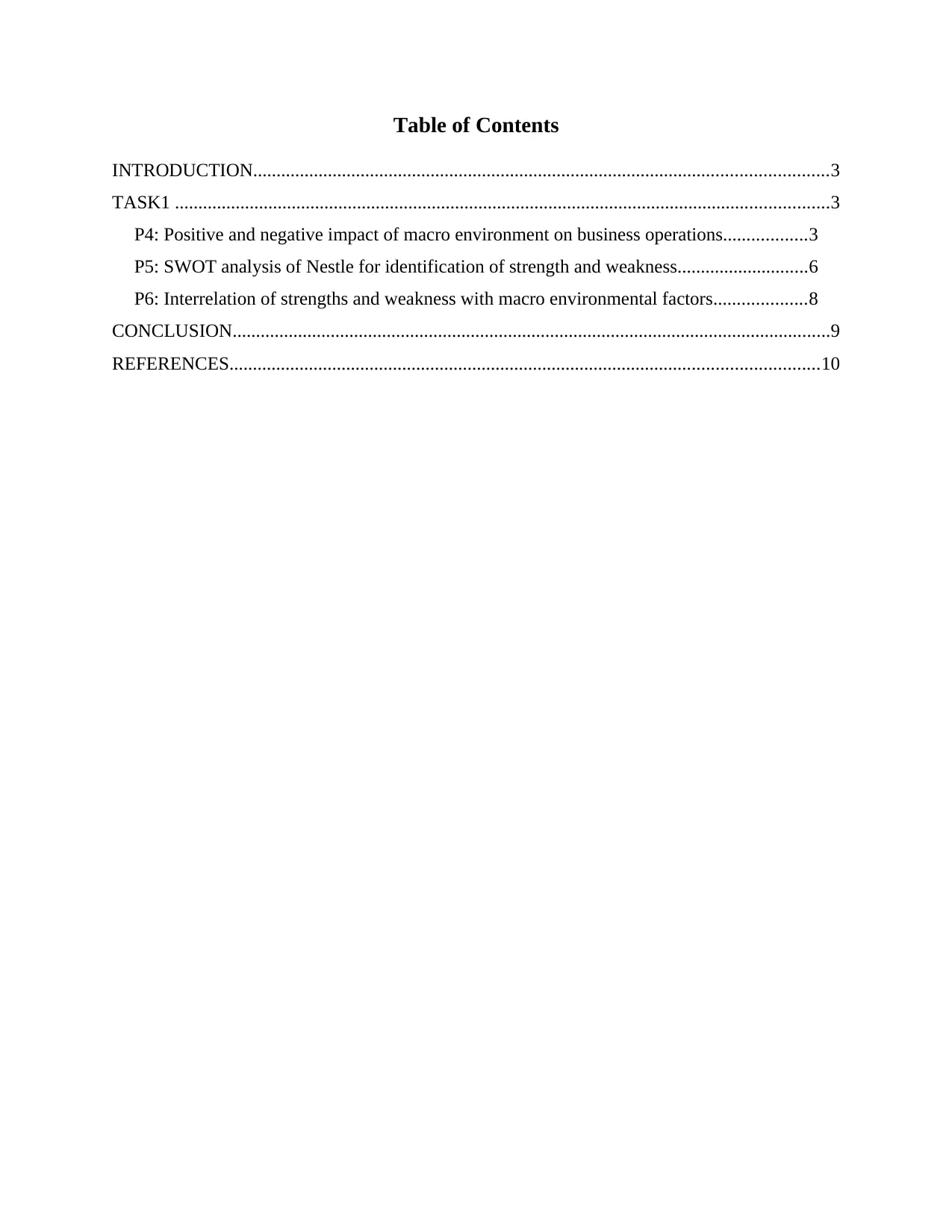
Table of Contents
INTRODUCTION...........................................................................................................................3
TASK1 ............................................................................................................................................3
P4: Positive and negative impact of macro environment on business operations..................3
P5: SWOT analysis of Nestle for identification of strength and weakness............................6
P6: Interrelation of strengths and weakness with macro environmental factors....................8
CONCLUSION................................................................................................................................9
REFERENCES..............................................................................................................................10
INTRODUCTION...........................................................................................................................3
TASK1 ............................................................................................................................................3
P4: Positive and negative impact of macro environment on business operations..................3
P5: SWOT analysis of Nestle for identification of strength and weakness............................6
P6: Interrelation of strengths and weakness with macro environmental factors....................8
CONCLUSION................................................................................................................................9
REFERENCES..............................................................................................................................10
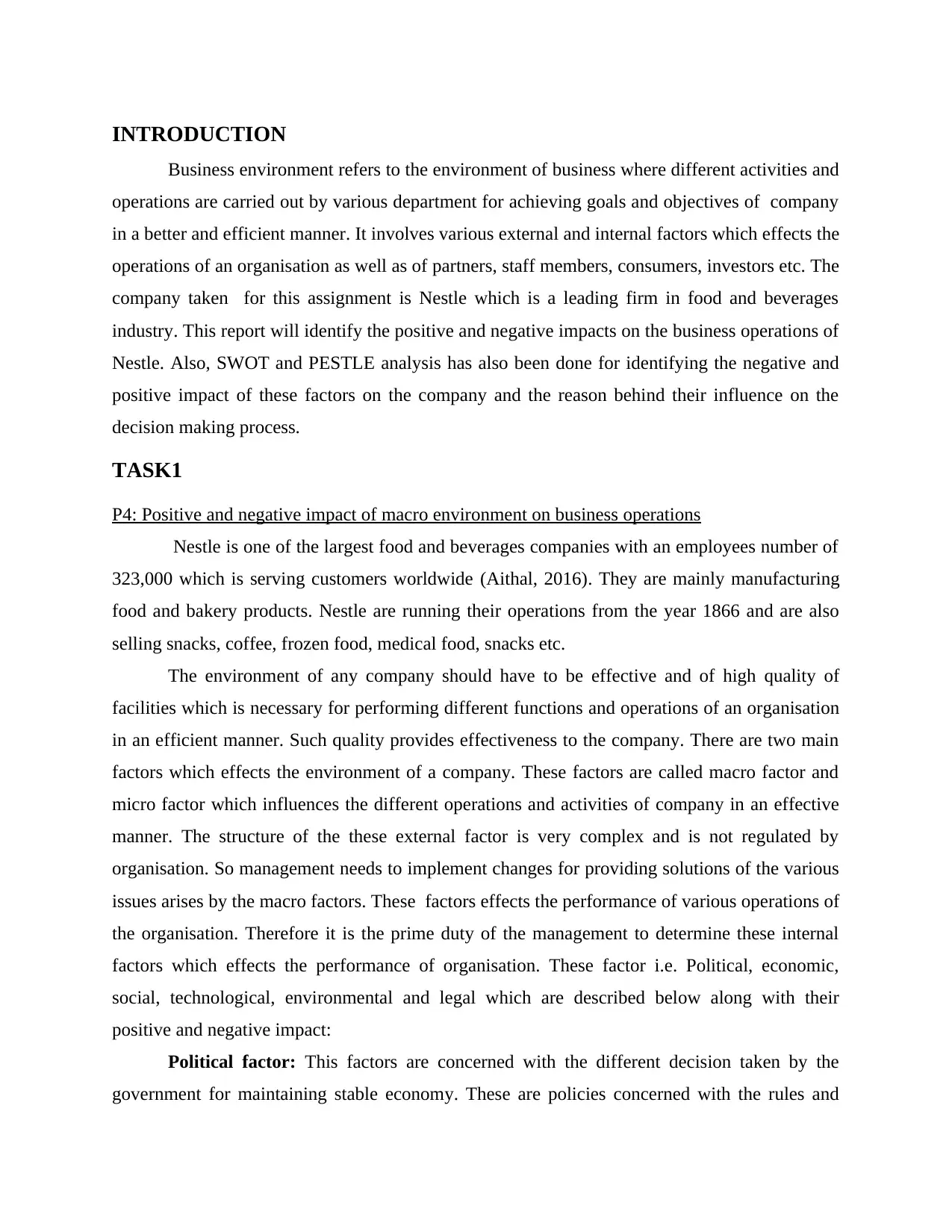
INTRODUCTION
Business environment refers to the environment of business where different activities and
operations are carried out by various department for achieving goals and objectives of company
in a better and efficient manner. It involves various external and internal factors which effects the
operations of an organisation as well as of partners, staff members, consumers, investors etc. The
company taken for this assignment is Nestle which is a leading firm in food and beverages
industry. This report will identify the positive and negative impacts on the business operations of
Nestle. Also, SWOT and PESTLE analysis has also been done for identifying the negative and
positive impact of these factors on the company and the reason behind their influence on the
decision making process.
TASK1
P4: Positive and negative impact of macro environment on business operations
Nestle is one of the largest food and beverages companies with an employees number of
323,000 which is serving customers worldwide (Aithal, 2016). They are mainly manufacturing
food and bakery products. Nestle are running their operations from the year 1866 and are also
selling snacks, coffee, frozen food, medical food, snacks etc.
The environment of any company should have to be effective and of high quality of
facilities which is necessary for performing different functions and operations of an organisation
in an efficient manner. Such quality provides effectiveness to the company. There are two main
factors which effects the environment of a company. These factors are called macro factor and
micro factor which influences the different operations and activities of company in an effective
manner. The structure of the these external factor is very complex and is not regulated by
organisation. So management needs to implement changes for providing solutions of the various
issues arises by the macro factors. These factors effects the performance of various operations of
the organisation. Therefore it is the prime duty of the management to determine these internal
factors which effects the performance of organisation. These factor i.e. Political, economic,
social, technological, environmental and legal which are described below along with their
positive and negative impact:
Political factor: This factors are concerned with the different decision taken by the
government for maintaining stable economy. These are policies concerned with the rules and
Business environment refers to the environment of business where different activities and
operations are carried out by various department for achieving goals and objectives of company
in a better and efficient manner. It involves various external and internal factors which effects the
operations of an organisation as well as of partners, staff members, consumers, investors etc. The
company taken for this assignment is Nestle which is a leading firm in food and beverages
industry. This report will identify the positive and negative impacts on the business operations of
Nestle. Also, SWOT and PESTLE analysis has also been done for identifying the negative and
positive impact of these factors on the company and the reason behind their influence on the
decision making process.
TASK1
P4: Positive and negative impact of macro environment on business operations
Nestle is one of the largest food and beverages companies with an employees number of
323,000 which is serving customers worldwide (Aithal, 2016). They are mainly manufacturing
food and bakery products. Nestle are running their operations from the year 1866 and are also
selling snacks, coffee, frozen food, medical food, snacks etc.
The environment of any company should have to be effective and of high quality of
facilities which is necessary for performing different functions and operations of an organisation
in an efficient manner. Such quality provides effectiveness to the company. There are two main
factors which effects the environment of a company. These factors are called macro factor and
micro factor which influences the different operations and activities of company in an effective
manner. The structure of the these external factor is very complex and is not regulated by
organisation. So management needs to implement changes for providing solutions of the various
issues arises by the macro factors. These factors effects the performance of various operations of
the organisation. Therefore it is the prime duty of the management to determine these internal
factors which effects the performance of organisation. These factor i.e. Political, economic,
social, technological, environmental and legal which are described below along with their
positive and negative impact:
Political factor: This factors are concerned with the different decision taken by the
government for maintaining stable economy. These are policies concerned with the rules and
⊘ This is a preview!⊘
Do you want full access?
Subscribe today to unlock all pages.

Trusted by 1+ million students worldwide
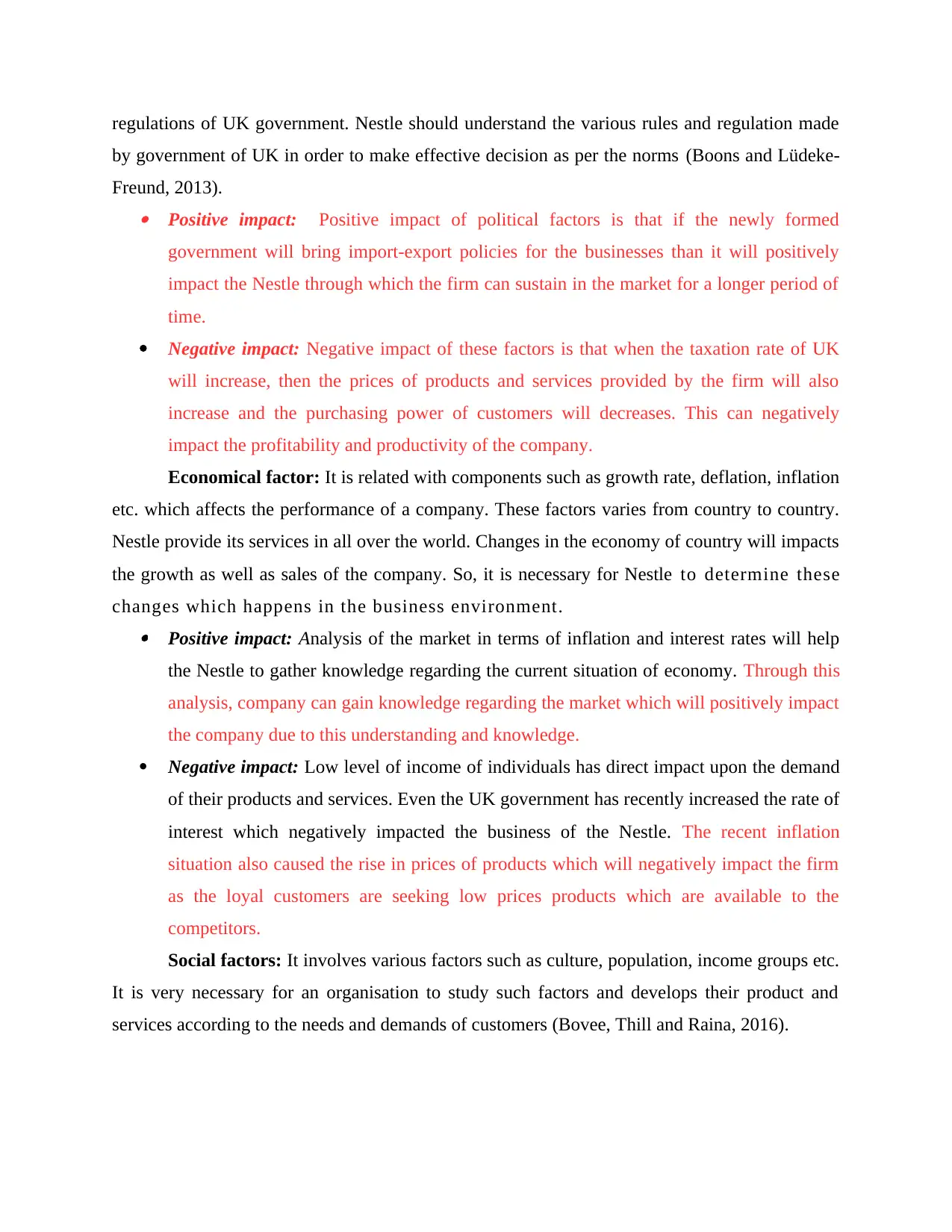
regulations of UK government. Nestle should understand the various rules and regulation made
by government of UK in order to make effective decision as per the norms (Boons and Lüdeke-
Freund, 2013). Positive impact: Positive impact of political factors is that if the newly formed
government will bring import-export policies for the businesses than it will positively
impact the Nestle through which the firm can sustain in the market for a longer period of
time.
Negative impact: Negative impact of these factors is that when the taxation rate of UK
will increase, then the prices of products and services provided by the firm will also
increase and the purchasing power of customers will decreases. This can negatively
impact the profitability and productivity of the company.
Economical factor: It is related with components such as growth rate, deflation, inflation
etc. which affects the performance of a company. These factors varies from country to country.
Nestle provide its services in all over the world. Changes in the economy of country will impacts
the growth as well as sales of the company. So, it is necessary for Nestle to determine these
changes which happens in the business environment. Positive impact: Analysis of the market in terms of inflation and interest rates will help
the Nestle to gather knowledge regarding the current situation of economy. Through this
analysis, company can gain knowledge regarding the market which will positively impact
the company due to this understanding and knowledge.
Negative impact: Low level of income of individuals has direct impact upon the demand
of their products and services. Even the UK government has recently increased the rate of
interest which negatively impacted the business of the Nestle. The recent inflation
situation also caused the rise in prices of products which will negatively impact the firm
as the loyal customers are seeking low prices products which are available to the
competitors.
Social factors: It involves various factors such as culture, population, income groups etc.
It is very necessary for an organisation to study such factors and develops their product and
services according to the needs and demands of customers (Bovee, Thill and Raina, 2016).
by government of UK in order to make effective decision as per the norms (Boons and Lüdeke-
Freund, 2013). Positive impact: Positive impact of political factors is that if the newly formed
government will bring import-export policies for the businesses than it will positively
impact the Nestle through which the firm can sustain in the market for a longer period of
time.
Negative impact: Negative impact of these factors is that when the taxation rate of UK
will increase, then the prices of products and services provided by the firm will also
increase and the purchasing power of customers will decreases. This can negatively
impact the profitability and productivity of the company.
Economical factor: It is related with components such as growth rate, deflation, inflation
etc. which affects the performance of a company. These factors varies from country to country.
Nestle provide its services in all over the world. Changes in the economy of country will impacts
the growth as well as sales of the company. So, it is necessary for Nestle to determine these
changes which happens in the business environment. Positive impact: Analysis of the market in terms of inflation and interest rates will help
the Nestle to gather knowledge regarding the current situation of economy. Through this
analysis, company can gain knowledge regarding the market which will positively impact
the company due to this understanding and knowledge.
Negative impact: Low level of income of individuals has direct impact upon the demand
of their products and services. Even the UK government has recently increased the rate of
interest which negatively impacted the business of the Nestle. The recent inflation
situation also caused the rise in prices of products which will negatively impact the firm
as the loyal customers are seeking low prices products which are available to the
competitors.
Social factors: It involves various factors such as culture, population, income groups etc.
It is very necessary for an organisation to study such factors and develops their product and
services according to the needs and demands of customers (Bovee, Thill and Raina, 2016).
Paraphrase This Document
Need a fresh take? Get an instant paraphrase of this document with our AI Paraphraser

Positive impact: Increase in the demand and needs of Nestle products like Maggie and
Paazta can enhance the profitability and sales of products which will ultimately help the
firm to obtain sustainability.
Negative impact: The people are preferring the low priced products due to the lack fo
education regarding the healthy food products which is negatively impacting the salse
and profit of Nestle.
Technological factors: Technology and innovation plays an essential role in growth and
success of a company. This is very significant for an organisation to use innovative methods to
gain competitive advantage in the market over others. For instance, Nestle can use the
opportunity of developing new and improved products of existing ones through the use of
advance technology which will helps to increase the productivity and effectiveness of
organisational performance. Positive impact: Adopting new techniques such as internet and e-commerce will help
Nestle in marketing and improvement of sales. It will also helps to build direct and strong
relationship with stakeholders.
Negative impact: Use of outdated techniques will decreases the quality of products and
will negatively impact the Nestle due to these low quality products.
Environmental factors: Every business organisation in today's world wants to use
sustainable resources for the development of their products and services. It is very necessary to
follow the regulations and laws of environment protection and meet their environmental targets.
For instance, Nestle can promote a healthy environment and climate which will increases
awareness among the public. It is very essential for a company to conduct various events on
environment as a part of CSR activity fro meeting their short and long term goals and target. Positive impact: The company is using environment friendly machines and equipments
for reducing the wastage in their production and processes to protect the environment.
Through this the customers also feels good when they get to know that the product they
are using is produced from sustainable resource which will positively effect the company.
Negative impact: Not following the environmental laws and regulations will lead to
negative effect on the brand image of Nestle as well as on the minds of customers which
will negatively effect the sales and profitability of the firm in the market.
Paazta can enhance the profitability and sales of products which will ultimately help the
firm to obtain sustainability.
Negative impact: The people are preferring the low priced products due to the lack fo
education regarding the healthy food products which is negatively impacting the salse
and profit of Nestle.
Technological factors: Technology and innovation plays an essential role in growth and
success of a company. This is very significant for an organisation to use innovative methods to
gain competitive advantage in the market over others. For instance, Nestle can use the
opportunity of developing new and improved products of existing ones through the use of
advance technology which will helps to increase the productivity and effectiveness of
organisational performance. Positive impact: Adopting new techniques such as internet and e-commerce will help
Nestle in marketing and improvement of sales. It will also helps to build direct and strong
relationship with stakeholders.
Negative impact: Use of outdated techniques will decreases the quality of products and
will negatively impact the Nestle due to these low quality products.
Environmental factors: Every business organisation in today's world wants to use
sustainable resources for the development of their products and services. It is very necessary to
follow the regulations and laws of environment protection and meet their environmental targets.
For instance, Nestle can promote a healthy environment and climate which will increases
awareness among the public. It is very essential for a company to conduct various events on
environment as a part of CSR activity fro meeting their short and long term goals and target. Positive impact: The company is using environment friendly machines and equipments
for reducing the wastage in their production and processes to protect the environment.
Through this the customers also feels good when they get to know that the product they
are using is produced from sustainable resource which will positively effect the company.
Negative impact: Not following the environmental laws and regulations will lead to
negative effect on the brand image of Nestle as well as on the minds of customers which
will negatively effect the sales and profitability of the firm in the market.
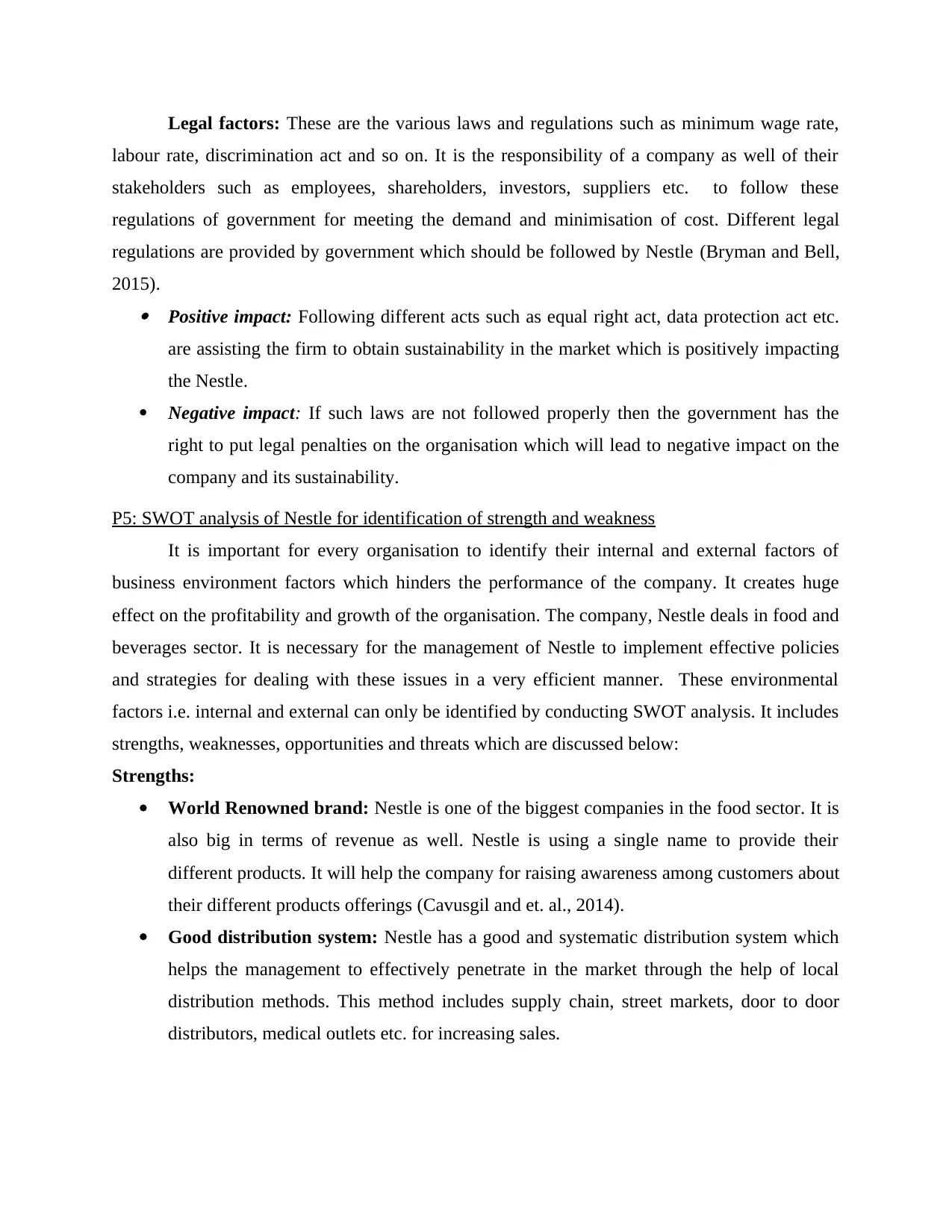
Legal factors: These are the various laws and regulations such as minimum wage rate,
labour rate, discrimination act and so on. It is the responsibility of a company as well of their
stakeholders such as employees, shareholders, investors, suppliers etc. to follow these
regulations of government for meeting the demand and minimisation of cost. Different legal
regulations are provided by government which should be followed by Nestle (Bryman and Bell,
2015). Positive impact: Following different acts such as equal right act, data protection act etc.
are assisting the firm to obtain sustainability in the market which is positively impacting
the Nestle.
Negative impact: If such laws are not followed properly then the government has the
right to put legal penalties on the organisation which will lead to negative impact on the
company and its sustainability.
P5: SWOT analysis of Nestle for identification of strength and weakness
It is important for every organisation to identify their internal and external factors of
business environment factors which hinders the performance of the company. It creates huge
effect on the profitability and growth of the organisation. The company, Nestle deals in food and
beverages sector. It is necessary for the management of Nestle to implement effective policies
and strategies for dealing with these issues in a very efficient manner. These environmental
factors i.e. internal and external can only be identified by conducting SWOT analysis. It includes
strengths, weaknesses, opportunities and threats which are discussed below:
Strengths:
World Renowned brand: Nestle is one of the biggest companies in the food sector. It is
also big in terms of revenue as well. Nestle is using a single name to provide their
different products. It will help the company for raising awareness among customers about
their different products offerings (Cavusgil and et. al., 2014).
Good distribution system: Nestle has a good and systematic distribution system which
helps the management to effectively penetrate in the market through the help of local
distribution methods. This method includes supply chain, street markets, door to door
distributors, medical outlets etc. for increasing sales.
labour rate, discrimination act and so on. It is the responsibility of a company as well of their
stakeholders such as employees, shareholders, investors, suppliers etc. to follow these
regulations of government for meeting the demand and minimisation of cost. Different legal
regulations are provided by government which should be followed by Nestle (Bryman and Bell,
2015). Positive impact: Following different acts such as equal right act, data protection act etc.
are assisting the firm to obtain sustainability in the market which is positively impacting
the Nestle.
Negative impact: If such laws are not followed properly then the government has the
right to put legal penalties on the organisation which will lead to negative impact on the
company and its sustainability.
P5: SWOT analysis of Nestle for identification of strength and weakness
It is important for every organisation to identify their internal and external factors of
business environment factors which hinders the performance of the company. It creates huge
effect on the profitability and growth of the organisation. The company, Nestle deals in food and
beverages sector. It is necessary for the management of Nestle to implement effective policies
and strategies for dealing with these issues in a very efficient manner. These environmental
factors i.e. internal and external can only be identified by conducting SWOT analysis. It includes
strengths, weaknesses, opportunities and threats which are discussed below:
Strengths:
World Renowned brand: Nestle is one of the biggest companies in the food sector. It is
also big in terms of revenue as well. Nestle is using a single name to provide their
different products. It will help the company for raising awareness among customers about
their different products offerings (Cavusgil and et. al., 2014).
Good distribution system: Nestle has a good and systematic distribution system which
helps the management to effectively penetrate in the market through the help of local
distribution methods. This method includes supply chain, street markets, door to door
distributors, medical outlets etc. for increasing sales.
⊘ This is a preview!⊘
Do you want full access?
Subscribe today to unlock all pages.

Trusted by 1+ million students worldwide
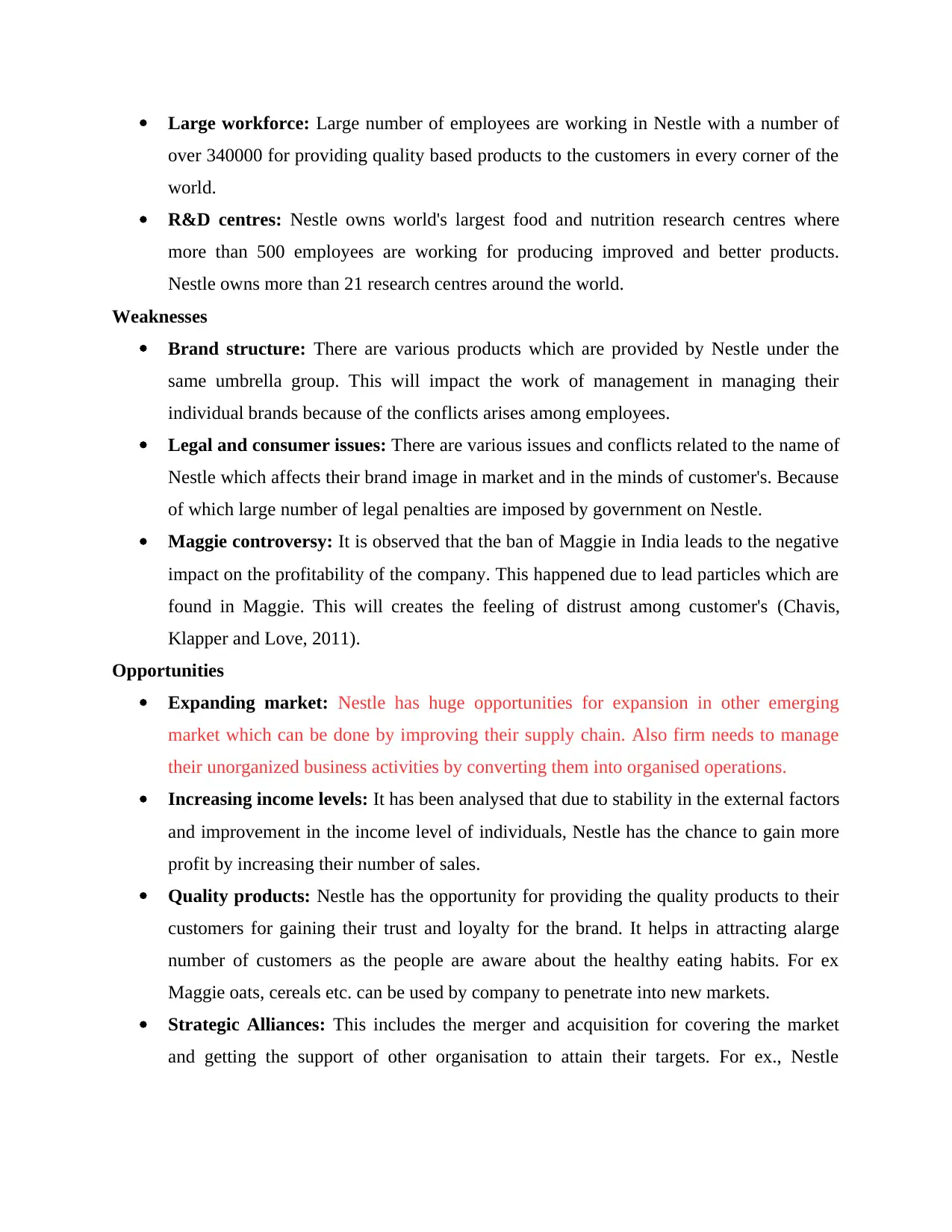
Large workforce: Large number of employees are working in Nestle with a number of
over 340000 for providing quality based products to the customers in every corner of the
world.
R&D centres: Nestle owns world's largest food and nutrition research centres where
more than 500 employees are working for producing improved and better products.
Nestle owns more than 21 research centres around the world.
Weaknesses
Brand structure: There are various products which are provided by Nestle under the
same umbrella group. This will impact the work of management in managing their
individual brands because of the conflicts arises among employees.
Legal and consumer issues: There are various issues and conflicts related to the name of
Nestle which affects their brand image in market and in the minds of customer's. Because
of which large number of legal penalties are imposed by government on Nestle.
Maggie controversy: It is observed that the ban of Maggie in India leads to the negative
impact on the profitability of the company. This happened due to lead particles which are
found in Maggie. This will creates the feeling of distrust among customer's (Chavis,
Klapper and Love, 2011).
Opportunities
Expanding market: Nestle has huge opportunities for expansion in other emerging
market which can be done by improving their supply chain. Also firm needs to manage
their unorganized business activities by converting them into organised operations.
Increasing income levels: It has been analysed that due to stability in the external factors
and improvement in the income level of individuals, Nestle has the chance to gain more
profit by increasing their number of sales.
Quality products: Nestle has the opportunity for providing the quality products to their
customers for gaining their trust and loyalty for the brand. It helps in attracting alarge
number of customers as the people are aware about the healthy eating habits. For ex
Maggie oats, cereals etc. can be used by company to penetrate into new markets.
Strategic Alliances: This includes the merger and acquisition for covering the market
and getting the support of other organisation to attain their targets. For ex., Nestle
over 340000 for providing quality based products to the customers in every corner of the
world.
R&D centres: Nestle owns world's largest food and nutrition research centres where
more than 500 employees are working for producing improved and better products.
Nestle owns more than 21 research centres around the world.
Weaknesses
Brand structure: There are various products which are provided by Nestle under the
same umbrella group. This will impact the work of management in managing their
individual brands because of the conflicts arises among employees.
Legal and consumer issues: There are various issues and conflicts related to the name of
Nestle which affects their brand image in market and in the minds of customer's. Because
of which large number of legal penalties are imposed by government on Nestle.
Maggie controversy: It is observed that the ban of Maggie in India leads to the negative
impact on the profitability of the company. This happened due to lead particles which are
found in Maggie. This will creates the feeling of distrust among customer's (Chavis,
Klapper and Love, 2011).
Opportunities
Expanding market: Nestle has huge opportunities for expansion in other emerging
market which can be done by improving their supply chain. Also firm needs to manage
their unorganized business activities by converting them into organised operations.
Increasing income levels: It has been analysed that due to stability in the external factors
and improvement in the income level of individuals, Nestle has the chance to gain more
profit by increasing their number of sales.
Quality products: Nestle has the opportunity for providing the quality products to their
customers for gaining their trust and loyalty for the brand. It helps in attracting alarge
number of customers as the people are aware about the healthy eating habits. For ex
Maggie oats, cereals etc. can be used by company to penetrate into new markets.
Strategic Alliances: This includes the merger and acquisition for covering the market
and getting the support of other organisation to attain their targets. For ex., Nestle
Paraphrase This Document
Need a fresh take? Get an instant paraphrase of this document with our AI Paraphraser
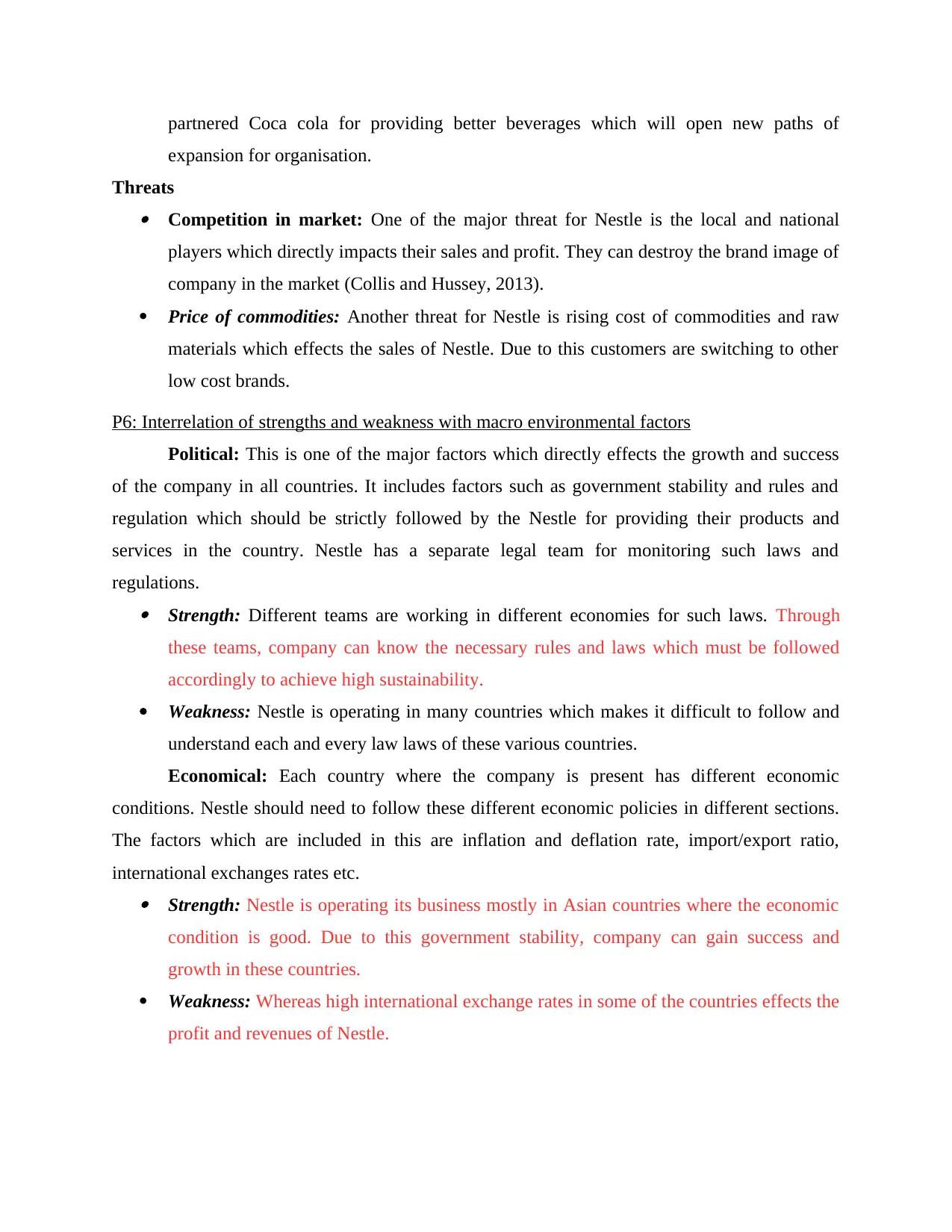
partnered Coca cola for providing better beverages which will open new paths of
expansion for organisation.
Threats Competition in market: One of the major threat for Nestle is the local and national
players which directly impacts their sales and profit. They can destroy the brand image of
company in the market (Collis and Hussey, 2013).
Price of commodities: Another threat for Nestle is rising cost of commodities and raw
materials which effects the sales of Nestle. Due to this customers are switching to other
low cost brands.
P6: Interrelation of strengths and weakness with macro environmental factors
Political: This is one of the major factors which directly effects the growth and success
of the company in all countries. It includes factors such as government stability and rules and
regulation which should be strictly followed by the Nestle for providing their products and
services in the country. Nestle has a separate legal team for monitoring such laws and
regulations. Strength: Different teams are working in different economies for such laws. Through
these teams, company can know the necessary rules and laws which must be followed
accordingly to achieve high sustainability.
Weakness: Nestle is operating in many countries which makes it difficult to follow and
understand each and every law laws of these various countries.
Economical: Each country where the company is present has different economic
conditions. Nestle should need to follow these different economic policies in different sections.
The factors which are included in this are inflation and deflation rate, import/export ratio,
international exchanges rates etc. Strength: Nestle is operating its business mostly in Asian countries where the economic
condition is good. Due to this government stability, company can gain success and
growth in these countries.
Weakness: Whereas high international exchange rates in some of the countries effects the
profit and revenues of Nestle.
expansion for organisation.
Threats Competition in market: One of the major threat for Nestle is the local and national
players which directly impacts their sales and profit. They can destroy the brand image of
company in the market (Collis and Hussey, 2013).
Price of commodities: Another threat for Nestle is rising cost of commodities and raw
materials which effects the sales of Nestle. Due to this customers are switching to other
low cost brands.
P6: Interrelation of strengths and weakness with macro environmental factors
Political: This is one of the major factors which directly effects the growth and success
of the company in all countries. It includes factors such as government stability and rules and
regulation which should be strictly followed by the Nestle for providing their products and
services in the country. Nestle has a separate legal team for monitoring such laws and
regulations. Strength: Different teams are working in different economies for such laws. Through
these teams, company can know the necessary rules and laws which must be followed
accordingly to achieve high sustainability.
Weakness: Nestle is operating in many countries which makes it difficult to follow and
understand each and every law laws of these various countries.
Economical: Each country where the company is present has different economic
conditions. Nestle should need to follow these different economic policies in different sections.
The factors which are included in this are inflation and deflation rate, import/export ratio,
international exchanges rates etc. Strength: Nestle is operating its business mostly in Asian countries where the economic
condition is good. Due to this government stability, company can gain success and
growth in these countries.
Weakness: Whereas high international exchange rates in some of the countries effects the
profit and revenues of Nestle.

Social: These are related to cultural aspects, attitudes and beliefs of customers. It will
have huge effect on the demand and business activities of the company as well as customers.
These factors includes demographics, work ethic, lifestyle trends etc (Grimpe and Kaiser, 2010). Strength: R&D department of Nestle is their main strength. It helps in determining the
trends and changes in the market for producing quality products based on the preferences
of customers and influencing their behaviour to buy the products of company.
Weakness: A large number of employees are working in Nestle which leads to rise in
conflicts and issues due to cultural differences and lack of professional ethics.
Technological: This involves various technological aspects such as innovations, barriers
and incentives etc. It is the responsibility of the management to adopt new and updated tools and
for improving the quality of produced products and services. Strength: Nestle is uses new techniques and technologies in their operations for fulfilling
the quality standards which are directed by government. Nestle has good technical team
and R&D team which provides training to the employees for improving their skills for
better productivity and performance and also to use new technologies in their working
(Hair, 2015).
Weakness: Adoption of new technologies will increase the production cost of Nestle. It
can effects the affordable price policy of Nestle which will also effect their sales and
profitability.
How SWOT analysis influence decision making process
This analysis aid the management of nestle to implement effective plans and policies for
ensuring the sustainability and growth of the company in the present market. So, It is important
to consider the strengths. opportunities, threats and weaknesses before reaching at any
conclusion or taking any judgements. Management of Nestle should focus on the facts and
figures which provides weakness and threat to the organisation. such as inexperienced staff
members is identified as weakness of company which leads to negative publicity of the brand
image of company. They can overcome it by recruiting skilled and energetic staff (Pulver, 2012).
The firm needs to monitor their growth and sustainability in the different markets for
implementing effective strategies to enhance the growth.
have huge effect on the demand and business activities of the company as well as customers.
These factors includes demographics, work ethic, lifestyle trends etc (Grimpe and Kaiser, 2010). Strength: R&D department of Nestle is their main strength. It helps in determining the
trends and changes in the market for producing quality products based on the preferences
of customers and influencing their behaviour to buy the products of company.
Weakness: A large number of employees are working in Nestle which leads to rise in
conflicts and issues due to cultural differences and lack of professional ethics.
Technological: This involves various technological aspects such as innovations, barriers
and incentives etc. It is the responsibility of the management to adopt new and updated tools and
for improving the quality of produced products and services. Strength: Nestle is uses new techniques and technologies in their operations for fulfilling
the quality standards which are directed by government. Nestle has good technical team
and R&D team which provides training to the employees for improving their skills for
better productivity and performance and also to use new technologies in their working
(Hair, 2015).
Weakness: Adoption of new technologies will increase the production cost of Nestle. It
can effects the affordable price policy of Nestle which will also effect their sales and
profitability.
How SWOT analysis influence decision making process
This analysis aid the management of nestle to implement effective plans and policies for
ensuring the sustainability and growth of the company in the present market. So, It is important
to consider the strengths. opportunities, threats and weaknesses before reaching at any
conclusion or taking any judgements. Management of Nestle should focus on the facts and
figures which provides weakness and threat to the organisation. such as inexperienced staff
members is identified as weakness of company which leads to negative publicity of the brand
image of company. They can overcome it by recruiting skilled and energetic staff (Pulver, 2012).
The firm needs to monitor their growth and sustainability in the different markets for
implementing effective strategies to enhance the growth.
⊘ This is a preview!⊘
Do you want full access?
Subscribe today to unlock all pages.

Trusted by 1+ million students worldwide
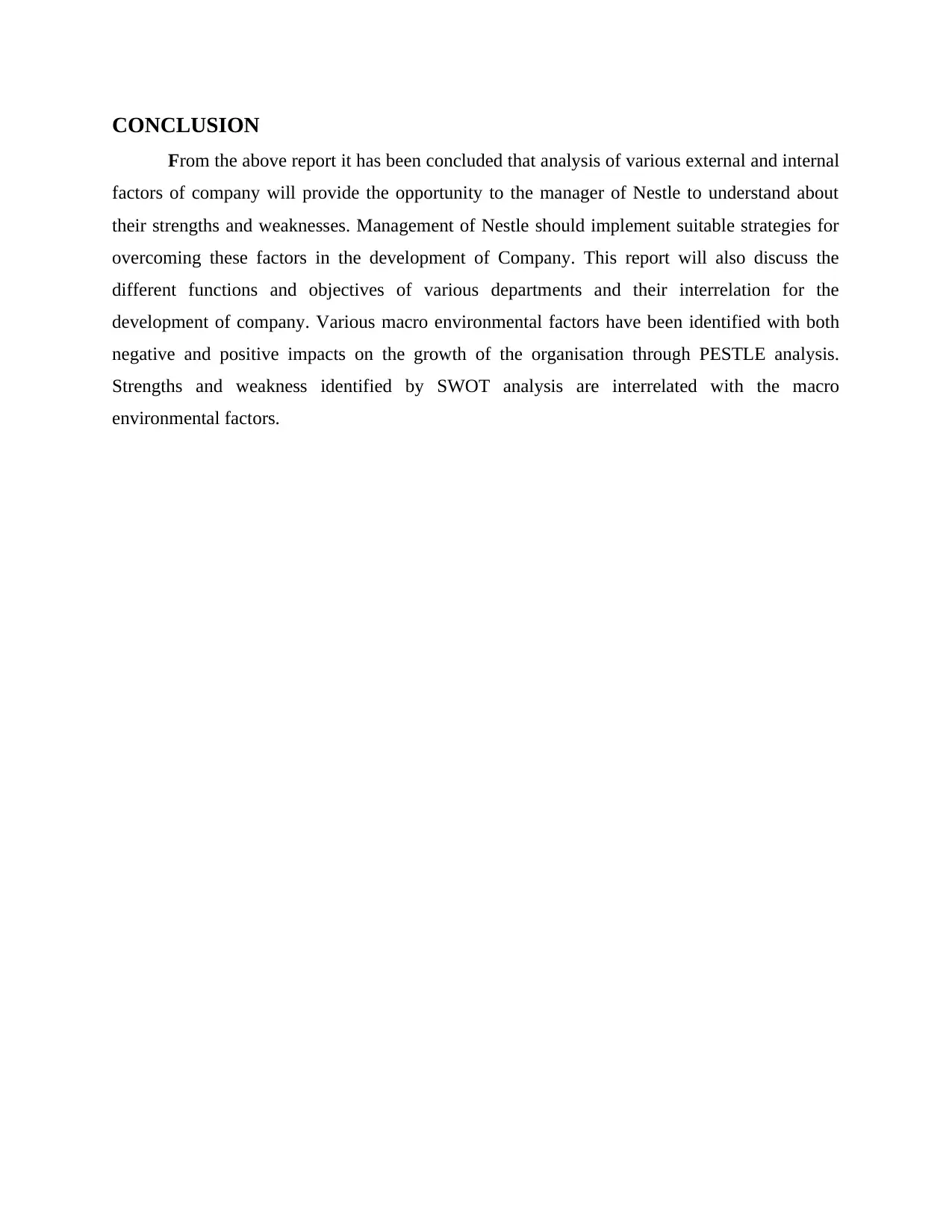
CONCLUSION
From the above report it has been concluded that analysis of various external and internal
factors of company will provide the opportunity to the manager of Nestle to understand about
their strengths and weaknesses. Management of Nestle should implement suitable strategies for
overcoming these factors in the development of Company. This report will also discuss the
different functions and objectives of various departments and their interrelation for the
development of company. Various macro environmental factors have been identified with both
negative and positive impacts on the growth of the organisation through PESTLE analysis.
Strengths and weakness identified by SWOT analysis are interrelated with the macro
environmental factors.
From the above report it has been concluded that analysis of various external and internal
factors of company will provide the opportunity to the manager of Nestle to understand about
their strengths and weaknesses. Management of Nestle should implement suitable strategies for
overcoming these factors in the development of Company. This report will also discuss the
different functions and objectives of various departments and their interrelation for the
development of company. Various macro environmental factors have been identified with both
negative and positive impacts on the growth of the organisation through PESTLE analysis.
Strengths and weakness identified by SWOT analysis are interrelated with the macro
environmental factors.
Paraphrase This Document
Need a fresh take? Get an instant paraphrase of this document with our AI Paraphraser

REFERENCES
Aithal, P. S., 2016. Study on ABCD analysis technique for business models, business strategies,
operating concepts & business systems. Browser Download This Paper.
Boons, F. and Lüdeke-Freund, F., 2013. Business models for sustainable innovation: state-of-
the-art and steps towards a research agenda. Journal of Cleaner Production. 45. pp.9-
19.
Bovee, C. L., Thill, J. V. and Raina, R. L., 2016. Business communication today. Pearson
Education India.
Bryman, A. and Bell, E., 2015. Business research methods. Oxford University Press, USA.
Cavusgil, S. T. and et. al., 2014. International business. Pearson Australia.
Chavis, L. W., Klapper, L. F. and Love, I., 2011. The impact of the business environment on
young firm financing. The world bank economic review. 25(3). pp.486-507.
Collis, J. and Hussey, R., 2013. Business research: A practical guide for undergraduate and
postgraduate students. Palgrave macmillan.
Grimpe, C and Kaiser, U., 2010. Balancing internal and external knowledge acquisition: the
gains and pains from R&D outsourcing. Journal of management studies. 47(8).
pp.1483-1509.
Hair, J. F., 2015. Essentials of business research methods. ME Sharpe.
Pulver, S., 2012. Business and the Environment.
Aithal, P. S., 2016. Study on ABCD analysis technique for business models, business strategies,
operating concepts & business systems. Browser Download This Paper.
Boons, F. and Lüdeke-Freund, F., 2013. Business models for sustainable innovation: state-of-
the-art and steps towards a research agenda. Journal of Cleaner Production. 45. pp.9-
19.
Bovee, C. L., Thill, J. V. and Raina, R. L., 2016. Business communication today. Pearson
Education India.
Bryman, A. and Bell, E., 2015. Business research methods. Oxford University Press, USA.
Cavusgil, S. T. and et. al., 2014. International business. Pearson Australia.
Chavis, L. W., Klapper, L. F. and Love, I., 2011. The impact of the business environment on
young firm financing. The world bank economic review. 25(3). pp.486-507.
Collis, J. and Hussey, R., 2013. Business research: A practical guide for undergraduate and
postgraduate students. Palgrave macmillan.
Grimpe, C and Kaiser, U., 2010. Balancing internal and external knowledge acquisition: the
gains and pains from R&D outsourcing. Journal of management studies. 47(8).
pp.1483-1509.
Hair, J. F., 2015. Essentials of business research methods. ME Sharpe.
Pulver, S., 2012. Business and the Environment.
1 out of 11
Related Documents
Your All-in-One AI-Powered Toolkit for Academic Success.
+13062052269
info@desklib.com
Available 24*7 on WhatsApp / Email
![[object Object]](/_next/static/media/star-bottom.7253800d.svg)
Unlock your academic potential
Copyright © 2020–2025 A2Z Services. All Rights Reserved. Developed and managed by ZUCOL.





